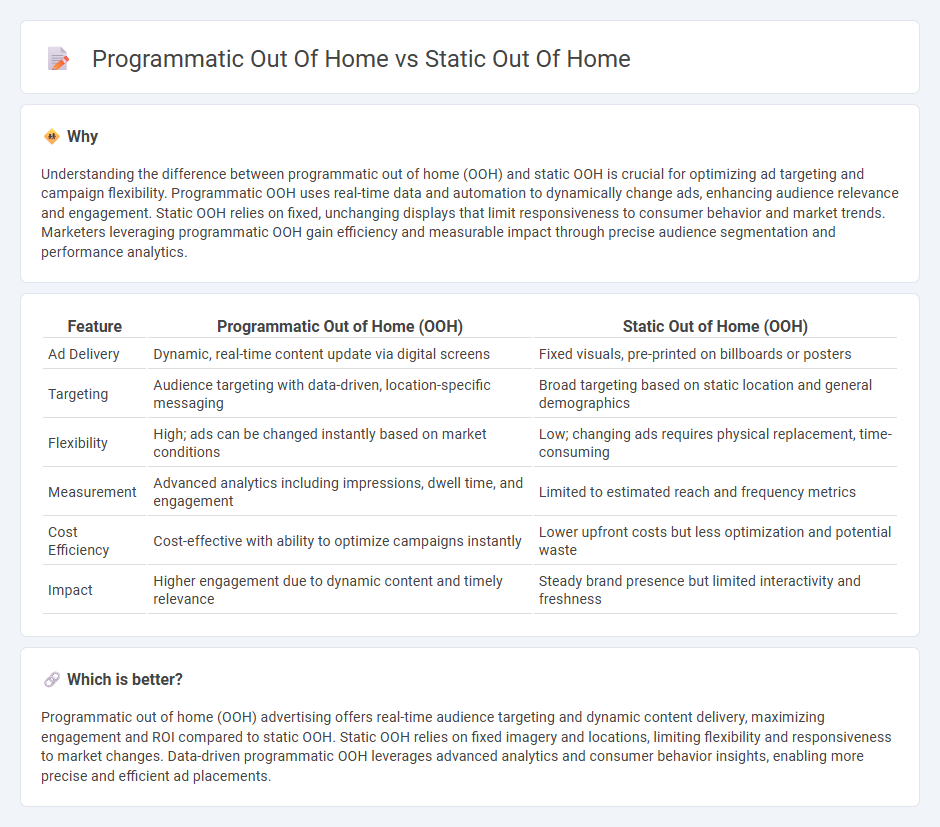
Programmatic Out of Home (OOH) advertising leverages real-time data and automated technology to deliver dynamic content tailored to specific audiences, enhancing engagement and campaign efficiency. In contrast, Static OOH uses fixed imagery and messaging, providing consistent but less flexible brand exposure. Explore the advantages and applications of both to optimize your marketing strategy.
Why it is important
Understanding the difference between programmatic out of home (OOH) and static OOH is crucial for optimizing ad targeting and campaign flexibility. Programmatic OOH uses real-time data and automation to dynamically change ads, enhancing audience relevance and engagement. Static OOH relies on fixed, unchanging displays that limit responsiveness to consumer behavior and market trends. Marketers leveraging programmatic OOH gain efficiency and measurable impact through precise audience segmentation and performance analytics.
Comparison Table
| Feature | Programmatic Out of Home (OOH) | Static Out of Home (OOH) |
|---|---|---|
| Ad Delivery | Dynamic, real-time content update via digital screens | Fixed visuals, pre-printed on billboards or posters |
| Targeting | Audience targeting with data-driven, location-specific messaging | Broad targeting based on static location and general demographics |
| Flexibility | High; ads can be changed instantly based on market conditions | Low; changing ads requires physical replacement, time-consuming |
| Measurement | Advanced analytics including impressions, dwell time, and engagement | Limited to estimated reach and frequency metrics |
| Cost Efficiency | Cost-effective with ability to optimize campaigns instantly | Lower upfront costs but less optimization and potential waste |
| Impact | Higher engagement due to dynamic content and timely relevance | Steady brand presence but limited interactivity and freshness |
Which is better?
Programmatic out of home (OOH) advertising offers real-time audience targeting and dynamic content delivery, maximizing engagement and ROI compared to static OOH. Static OOH relies on fixed imagery and locations, limiting flexibility and responsiveness to market changes. Data-driven programmatic OOH leverages advanced analytics and consumer behavior insights, enabling more precise and efficient ad placements.
Connection
Programmatic out-of-home (OOH) leverages automated technology to buy and display ads dynamically on digital billboards, enhancing targeting and real-time content updates compared to traditional static OOH, which uses fixed, non-digital billboards. Both mediums complement each other by combining the broad reach and physical presence of static OOH with the data-driven precision and flexibility of programmatic OOH, increasing overall campaign effectiveness. Integrating these strategies allows marketers to optimize audience engagement across various locations and times using location-based data and consumer insights.
Key Terms
Inventory Access
Static out of home (OOH) advertising offers fixed inventory with long-term placements, limiting flexibility and responsiveness to market trends. Programmatic out of home leverages real-time data and automated buying, providing broader inventory access across various digital screens and locations, enabling dynamic content delivery and targeted campaigns. Explore the advantages of programmatic OOH for enhanced inventory reach and campaign efficiency.
Audience Targeting
Static out of home (OOH) advertising relies on fixed placements with limited audience targeting, offering broad visibility but less precision in reaching specific demographics. Programmatic out of home leverages real-time data and digital networks to dynamically target audiences based on factors such as location, time, and behavioral insights, significantly enhancing campaign relevance and engagement. Discover how programmatic OOH transforms audience targeting for more effective advertising strategies.
Real-Time Bidding
Static out-of-home (OOH) advertising delivers fixed content on physical billboards or posters, lacking the flexibility of programmatic OOH, which uses real-time bidding (RTB) to dynamically purchase ad space and tailor messages based on audience data and context. Programmatic OOH leverages RTB platforms to automate and optimize media buys, enhancing targeting precision, campaign efficiency, and ROI by responding instantaneously to market demand and environmental factors. Explore the advantages of real-time bidding in programmatic out-of-home to transform your advertising strategy and maximize impact.
Source and External Links
Why static billboards thrive in the digital age: Insights for advertisers - Static out of home (OOH) advertising like billboards offers long-term visibility, high-impact messaging, and 100% share of voice by displaying large, eye-catching visuals continuously without sharing space with other ads, making it ideal for sustained brand awareness and local targeting campaigns.
Balancing Digital and Static OOH for Maximum Impact - Static OOH media, including billboards, posters, and transit ads, remain relevant by providing trusted, visible advertising formats that complement digital ads, offering distinctive benefits such as permanence and physical presence in the urban environment.
How to Remove Static in Your Home - In a different context, static refers to the buildup of electrical charge causing shocks; reducing static indoors involves increasing humidity and cleaning surfaces, but this differs from static OOH, which is about non-digital outdoor advertising displays.
 dowidth.com
dowidth.com